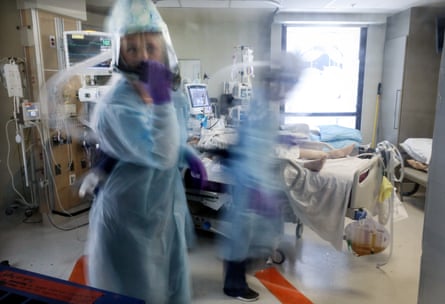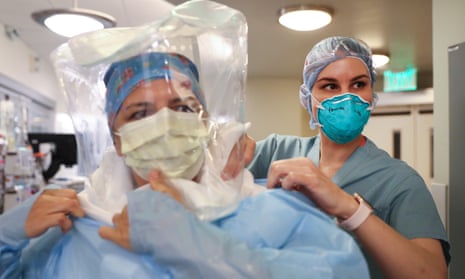Health workers in the US may be exposing themselves to dangerous chemicals by disinfecting and reusing their protective equipment, experts have warned.
Hospitals and other facilities have dealt with an extreme shortage of personal protective equipment (PPE), including N95 masks, gloves and gowns, by reusing equipment that would usually be discarded after use.
A range of practices to decontaminate equipment have been adopted, from storing equipment in paper bags for days, to using UV light and chemical disinfectants.
At Saint Catherine of Siena medical center, a hospital on Long Island, New York, healthcare workers reported spraying their reusable gowns with Virex II 256, a highly potent cleaner marketed for “hard, inanimate, nonporous surfaces” such as floors and walls.
In Colorado, health workers said they had been wiping down their face shields so frequently with the disinfectant CaviWipes that they became opaque.
The Centers for Disease Control and Prevention (CDC) offers guidance for healthcare practitioners reusing PPE when there is a severe shortage, including potentially reusing cloth isolation gowns without laundering them and cleaning face shields with federally registered hospital disinfectants.
But Virex, CaviWipes and most products included on the Environmental Protection Agency’s list of disinfectants for use against coronavirus have active ingredients that belong to a class of chemicals known as quaternary ammonium compounds, which release formaldehyde. Studies have shown these compounds can cause asthma, fertility issues and birth defects, and irritate the skin, eyes and lungs.
Ana Rule, director of the Exposure Assessment Lab at the Johns Hopkins Bloomberg School of Public Health, said these cleaners were most likely bought by the hospitals for very specific uses, such as sanitizing bed railings or other highly touched areas in isolation units.
She said: “Now these chemicals are being used everywhere. So you’re increasing the risk and the exposure and the concentration because you’re using them more broadly.”
A spokesperson for Diversey, which makes Virex, said it does not recommend using it on porous fabric or soft surfaces. The spokesperson said when Virex is used according to the instructions on the label, it is safe and effective.
KaVo Kerr, a manufacturer whose products include CaviWipes, said the cleaner has shown preliminary disinfectant success against the virus. Saint Catherine of Siena medical center did not respond to a request for comment.
Sarah Collins, an intensive care nurse at PeaceHealth Southwest medical center in Vancouver, Washington, said she and her colleagues have been wiping down the hoods of their powered air purifying respirators (PAPRs) every time they leave a potentially coronavirus-positive patient’s room, with the disinfecting wipe SideKick or Super Sani-Cloth. She said auditing nurses check to make sure they are wiping the inside and outside of the hoods with these cleaners.
Collins said she and her colleagues noticed warnings on the labels, including “harmful if inhaled or absorbed through skin” and “do not get in eyes or on clothing”, and became concerned.
She said: “A lot of us have felt like maybe our headaches and sore throats and fatigue have been caused by breathing in these harsh chemicals.”
The hospital said in a statement the process was started in response to the shortages of PAPR hoods, and that the practice has involved drying them and checking the integrity of the equipment before putting them on.
The CDC described a similar type of disinfectant cleaning method on PAPRs as “generally effective for use during a pandemic”, but cautioned that “chemical compatibility for PAPR components is not well understood”. PAPR manufacturers strongly recommend avoiding quaternary ammonium compounds.
Using these disinfectants so frequently, especially inside the hoods, could pose acute and long-term health risks, according to Lesliam Quirós-Alcalá, an assistant professor at the Johns Hopkins Bloomberg School of Public Health and an environmental epidemiologist.
“It’s in the breathing zone. It’s right there,” she said. “It’s prolonged periods because they’re going to be there with patients for a while, so it is a concern.”
A spokesperson for Stryker, the corporation whose products includes SideKick, emphasized the importance of customers following the product’s instructions for use.
Caitlin Stowe, of PDI Healthcare, which produces Super Sani-Cloth, said some people can be sensitive to the chemicals in their products, and suggested wiping the PPE down with a paper towel to remove residual chemical.
These decontamination methods have been viewed very much as temporary measures designed to keep workers safe until cases subside and a vaccine is discovered. But it is unclear how long this will last.

Quirós-Alcalá said: “This is something we need to keep in mind, because we don’t want to adopt practices for the long-term that may be detrimental to human health.”
This issue extends beyond the cleaning methods used within the walls of these hospitals, with companies now offering cleaning services for PPE, in order to allow for a simpler and more centralized system of decontamination and reuse.
David Pratt, health and safety representative for the New York State Nurses Association, gave the example of Medline Industries, a healthcare company that has been decontaminating masks using ethylene oxide. The CDC and 3M have said this is not recommended, and the CDC referenced the fact that this is carcinogenic and chronic inhalation has been linked to neurologic dysfunction.
“The idea that this would be used on these products that you put on your face afterwards is just outrageous,” Pratt told the Guardian.
Medline did not respond to a request for comment.
In recent weeks, at least half a dozen practices for disinfecting N95 masks have also been shown to decrease the filtration efficiency and thus make it possible for viral particles to get through, according to Melissa J Perry, chair of environmental and occupational health at George Washington University. These include using quaternary ammonium compounds, as well as bleach and ethanol.
The only protocols that appear to safely disinfect these masks are hydrogen peroxide vapor, UV radiation and a 65-90C heat treatment, Perry said.
